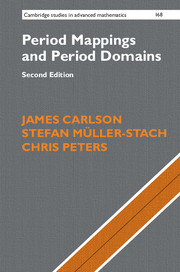Book contents
- Frontmatter
- Contents
- Preface to the Second Edition
- Preface to the First Edition
- PART ONE BASIC THEORY
- PART TWO ALGEBRAIC METHODS
- PART THREE DIFFERENTIAL GEOMETRIC METHODS
- PART FOUR ADDITIONAL TOPICS
- Appendix A Projective Varieties and Complex Manifolds
- Appendix B Homology and Cohomology
- Appendix C Vector Bundles and Chern Classes
- Appendix D Lie Groups and Algebraic Groups
- References
- Index
Preface to the First Edition
Published online by Cambridge University Press: 30 August 2017
- Frontmatter
- Contents
- Preface to the Second Edition
- Preface to the First Edition
- PART ONE BASIC THEORY
- PART TWO ALGEBRAIC METHODS
- PART THREE DIFFERENTIAL GEOMETRIC METHODS
- PART FOUR ADDITIONAL TOPICS
- Appendix A Projective Varieties and Complex Manifolds
- Appendix B Homology and Cohomology
- Appendix C Vector Bundles and Chern Classes
- Appendix D Lie Groups and Algebraic Groups
- References
- Index
Summary
What to expect of this book?
Our aim is to give an up to date exposition of the theory of period maps originally introduced by Griffiths. It is mainly intended as a text book for graduate students. However, it should also be of interest to any mathematician wishing to get introduced to those aspects of Hodge theory which are related to Griffiths’ theory.
Prerequisites
We assume that the reader has encountered complex or complex algebraic manifolds before. We have in mind familiarity with the concepts from the first chapters of the book by Griffiths and Harris (1978) or from the first half of the book by Forster (1981).
A second prerequisite is some familiarity with algebraic topology. For the fundamental group the reader may consult Forster's book (loc. cit.). Homology and cohomology are at the base of Hodge theory and so the reader should know either simplicial or singular homology and cohomology. A good source for the latter is Greenberg (1967).
Next, some familiarity with basic concepts and ideas from differential geometry such as smooth manifolds, differential forms, connections and characteristic classes is required. Apart from the book by Griffiths and Harris (1978) the reader is invited to consult the monograph by Guillemin and Pollack (1974). To have an idea of what we actually use in the book, we refer to the appendices. We occasionally refer to these in the main body of the book. We particularly recommend the exercises which are meant to provide the techniques necessary to calculate all sorts of invariants for concrete examples in the main text.
Contents of the book
The concept of a period-integral goes back to the nineteenth century; it was introduced by Legendre andWeierstras for integrals of certain elliptic functions over closed circuits in the dissected complex plane and of course is related to periodic functions like the Weierstras P-function. In modern terminology we would say that these integrals describe exactly how the complex structure of an elliptic curve varies. From this point of view the analogous question for higher genus curves becomes apparent and leads to period matrices and Torelli's theorem for curves. We have treated this historical starting point in the first chapter.
- Type
- Chapter
- Information
- Period Mappings and Period Domains , pp. xi - xivPublisher: Cambridge University PressPrint publication year: 2017



